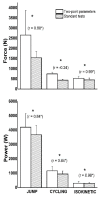Are the Parameters of Novel Two-Point Force-Velocity Model Generalizable in Leg Muscles?
- PMID: 33503856
- PMCID: PMC7908528
- DOI: 10.3390/ijerph18031032
Are the Parameters of Novel Two-Point Force-Velocity Model Generalizable in Leg Muscles?
Abstract
The two-point force-velocity model allows the assessment of the muscle mechanical capacities in fast, almost fatigue-free conditions. The aim of this study was to investigate the concurrent validity of the two-point parameters with directly measured force and power and to examine the generalization of the two-point parameters across the different functional movement tests of leg muscles. Twelve physically active participants were tested performing three functional lower limb maximal tests under two different magnitudes of loads: countermovement jumps, maximal cycling sprint, and maximal force under isokinetic conditions of the knee extensors. The results showed that all values from the two-point model were higher than the values from the standard tests (p < 0.05). We also found strong correlations between the same variables from different tests (r ≥ 0.84; p < 0.01), except for force in maximal cycling sprint, where it was low and negligible (r = -0.24). The results regarding our second aim showed that the correlation coefficients between the same two-point parameters of different lower limb tests ranged from moderate to strong (r -0.47 to 0.72). In particular, the relationships were stronger between power variables than between force variables and somewhat stronger between standard tests and two-point parameters. We can conclude that mechanical capacities of the leg muscles can be partially generalized between different functional tests.
Keywords: biomechanics; exercise; force-velocity relationship; performance; resistance; two-point model.
Conflict of interest statement
The authors declare no conflict of interest.
Figures



Similar articles
-
Sensitivity of the novel two-point force-velocity model: an assessment of leg muscle mechanical capacities.Sports Biomech. 2022 Aug;21(7):796-809. doi: 10.1080/14763141.2019.1691641. Epub 2020 Feb 5. Sports Biomech. 2022. PMID: 32022649
-
A Novel Two-Velocity Method for Elaborate Isokinetic Testing of Knee Extensors.Int J Sports Med. 2017 Sep;38(10):741-746. doi: 10.1055/s-0043-113043. Epub 2017 Aug 2. Int J Sports Med. 2017. PMID: 28768340
-
Force-velocity relationship of leg muscles assessed with motorized treadmill tests: Two-velocity method.Gait Posture. 2017 Jul;56:60-64. doi: 10.1016/j.gaitpost.2017.04.033. Epub 2017 May 4. Gait Posture. 2017. PMID: 28501023
-
Muscle mechanics: adaptations with exercise-training.Exerc Sport Sci Rev. 1996;24:427-73. Exerc Sport Sci Rev. 1996. PMID: 8744258 Review.
-
Force-velocity Relationship of Muscles Performing Multi-joint Maximum Performance Tasks.Int J Sports Med. 2015 Aug;36(9):699-704. doi: 10.1055/s-0035-1547283. Epub 2015 Mar 25. Int J Sports Med. 2015. PMID: 25806588 Review.
References
-
- McMahon T.A. Muscles, Reflexes, and Locomotion. Princeton University Press; Princeton, NJ, USA: 1984.
-
- Hill A.V. The heat of shortening and the dynamic constants of muscle. Proc. R. Soc. Lond. Ser. B-Biol. Sci. 1938;126:136–195.
-
- Janićijević D.N. Ph.D. Thesis. Univerzitet u Beogradu-Fakultet sporta i fizičkog vaspitanja; Belgrade, Serbia: Oct 1, 2020. Mechanical Capacities of the Different Muscle Groups Assessed Using “two-velocity” Method.
Publication types
MeSH terms
LinkOut - more resources
Full Text Sources
Other Literature Sources

